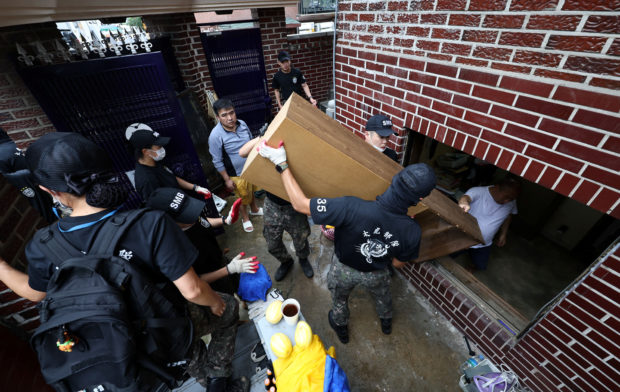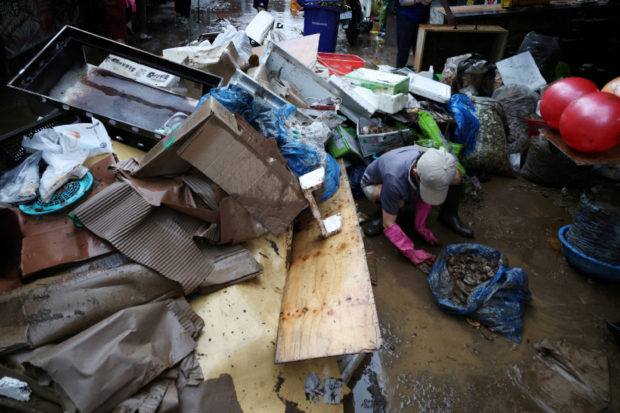
South Korean soldiers clean up debris from a house that had been submerged by torrential rain in Seoul, South Korea, August 10, 2022. Yonhap/via REUTERS
SEOUL — Using a plastic bowl, Ha In-sik bailed water out of his lower ground apartment in the low-income housing district of Sillim in southwestern Seoul on Wednesday, where flooding caused by torrential rain forced his family to sleep at a nearby park.
The 50-year-old man, along with his wife and daughter had collected home appliances, furniture, books and even cutlery, and put them outside to see what was salvageable.
The scene bore uncomfortable similarities with the sewage-flooded semi-basement flat depicted in the 2020 Oscar-winning South Korean film “Parasite,” that was a tale of growing social disparity in Asia’s fourth-largest economy.
The floods have caused inconvenience and monetary losses in the wealthier parts of the capital, like the glitzy Gangnam neighbourhood a few miles away.
But in places like Sillim, the floods have snuffed out what little hope desperate people like Ha had clung to in order just to keep going.
“I’ve got no money, nothing. But I had come here to live in this basement, as it was only option I had to live with my daughter,” Ha told Reuters.

An employee of a herbal medicine shop cleans up debris at a traditional market damaged by flood after torrential rain, in Seoul, South Korea, August 9, 2022. REUTERS FILE PHOTO
“But I’m hopeless now. Everything is gone, there’s no help and I don’t even have a spoon to eat food with.”
Ha wasn’t alone in his misery. Other residents in Sillim were scooping up water with large bowls or combing through the detritus to see whatever was still usable.
On Monday, three family members living in the neighborhood, including a woman with developmental disabilities, drowned in their lower ground apartment. President Yoon Suk-yeol visited Sillim a day later.
On Wednesday, Yoon apologized for the tragedy and called for measures to improve housing safety to protect old, poor or disabled people and families, like Ha’s, whose homes were most vulnerable to flooding.
At least 10 people have perished as a result of the torrential rain that has swept across the northern part of the country since Monday, knocking out power, causing landslides and flooding roads and subways.
This week’s deluge brought the heaviest rains in 115 years in Seoul, according to the Korea Meteorological Administration.
As of Wednesday, it said, six people were still missing, 570 have at least temporarily lost their homes, while 1,400 have been evacuated, mostly in Seoul, the Central Disaster and Safety Countermeasures Headquarters said.
South Korean soldiers clean up debris from a street that had been submerged by torrential rain in Seoul, South Korea, August 10, 2022. Yonhap/via REUTERS
As the rain clouds moved southwards on Wednesday, the recovery effort kicked into high gear, at least in the better off districts.
While large swathes of Sillim remained flooded, and residents likened conditions to a “mudbath”, in Gangnam most roads had been cleared and traffic was back to normal.
Ha said it would take about 10 days to get his apartment back to the point where he would move back in. He said the only help the government had offered was for temporary shelter at a gymnasium, which he rejected.
An official at the Gwanak district office, which covers Sillim, said that recovery efforts can be slower there due to the concentration of tiny apartments and houses lining the narrow streets, unlike Gangnam, which has wide boulevards and office buildings.
The official said the number of soldiers involved in the recovery would be raised from 210 to 500 on Thursday.
“We’re making all-out efforts to help residents, bringing everyone from our office, troops and volunteers,” the official said.
RELATED STORIES
South Korea continues search for those missing in torrential rain
Flooded Gangnam, a ‘slap in the face’ for Seoul mayor
Torrential rain lessens in South Korean capital amid heavy flood damage
More than 1,000 vehicles damaged by heavy rains in Seoul

